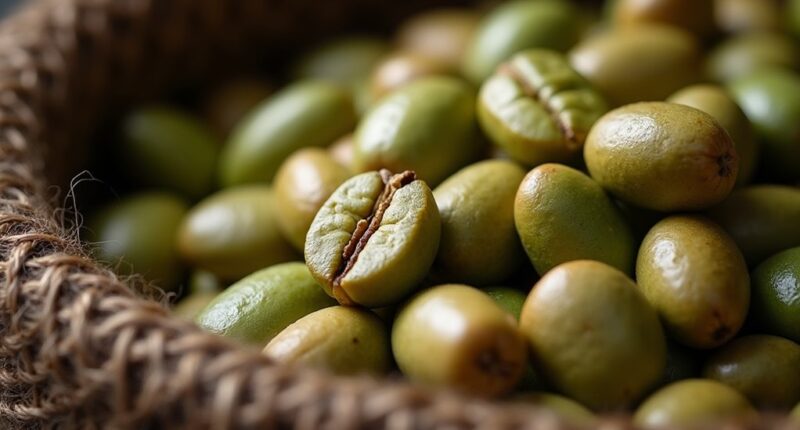So, green coffee is just unroasted coffee beans, packed with natural flavors and awesome health perks! They’ve got a pale green color and a fruity, grassy taste. You’ll usually find them in two main types: Arabica and Robusta. Arabica’s sweet, while Robusta’s bolder. It’s like a coffee with its pajamas on, waiting for a roast! Stick around, and you’ll find out how these beans jazz up your morning brew and why they’re getting so much buzz!
At a Glance
- Green coffee refers to unroasted coffee beans, typically pale green in color.
- It retains natural flavors and nutrients that are lost during roasting.
- The main species of green coffee are Arabica and Robusta, each with distinct flavor profiles.
- Green coffee is rich in chlorogenic acids, contributing to its health benefits.
- It is often used in supplements and brews for its antioxidant properties.
Definition of Green Coffee
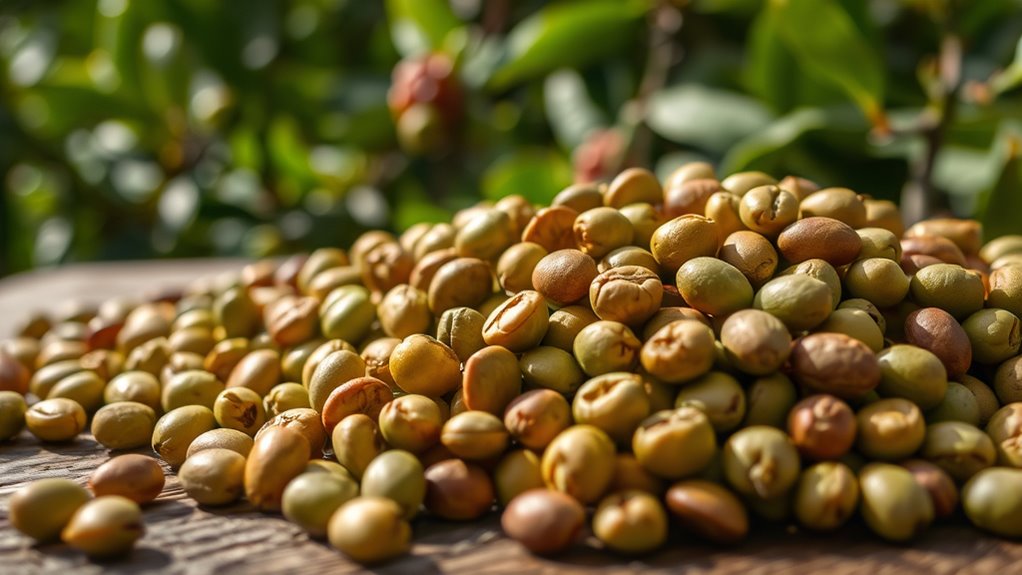
When you hear the term “green coffee,” you might picture some kind of funky new health drink, right? Well, think again!
Green coffee refers to unroasted coffee beans, still firm and dense, with colors ranging from greenish to yellowish hues. These little gems pack a punch when it comes to health benefits, thanks to their high levels of chlorogenic acids. Additionally, many coffee enthusiasts are exploring the potential of the perfect coffee bean to elevate their brewing experience.
Green coffee, those unroasted beans bursting with chlorogenic acids, are a powerhouse of health benefits waiting to be explored!
Plus, extraction methods allow you to enjoy their goodness in supplements or tasty brews. Just remember, the flavor’s a bit grassy and bitter, but hey, that’s part of the adventure, isn’t it?
Immerse yourself in the green coffee craze!
Main Species of Green Coffee
Green coffee isn’t just a trendy buzzword; it’s a whole world of flavor waiting to be explored! The main species you’ll come across are Arabica and Robusta. Arabica varieties are known for their smooth, complex flavors—think sweet and fruity! On the flip side, Robusta characteristics offer a bolder, earthier kick, perfect for espresso lovers. Colombian coffee beans, particularly those from the Finest Colombian Coffee Beans, are renowned for their exceptional Arabica varieties.
| Arabica Varieties | Robusta Characteristics |
|---|---|
| Typica | Higher caffeine content |
| Bourbon | Bitter, earthy flavors |
| Caturra | Hardier against pests |
| Sidra | Less flavor complexity |
Dive in and discover what suits your taste!
Popular Varietals of Arabica and Robusta
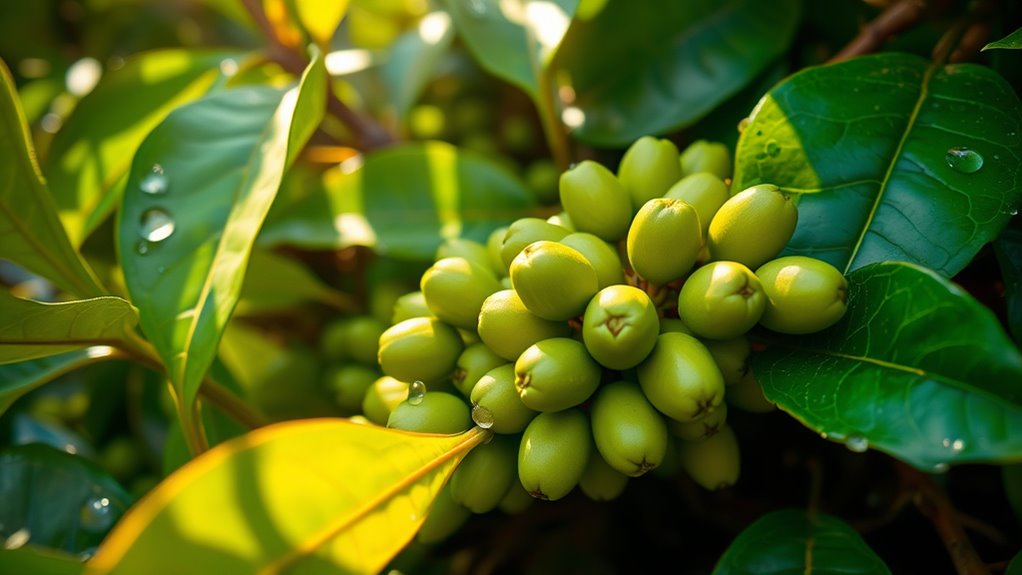
Coffee lovers, get ready to plunge into the delightful world of Arabica and Robusta varietals!
With so many Arabica varieties like Bourbon and Geisha, you’re in for a treat. Each brings its own unique flavors, from sweet to floral.
On the flip side, let’s not forget Robusta’s bold characteristics—more caffeine and a punchy taste that makes it a favorite in espresso blends. Plus, Robusta is easier to grow, so you’ll often find it in instant coffee.
Interestingly, the choice between these two beans can significantly affect your brewing experience, leading to different aroma and flavor profiles.
Whether you prefer the smoothness of Arabica or the robust kick of Robusta, there’s a perfect cup waiting just for you!
Geographic Origins of Green Coffee Beans
Did you know that the journey of your favorite coffee starts far away in some really fascinating places?
From the African origins of Ethiopia and Uganda, where fruity flavors burst forth, to the South American origins in Brazil and Colombia, known for their balanced nutty notes, each region adds its unique touch.
Southeast Asian origins, like Vietnam, bring earthy tones, while Central American origins, such as Guatemala, offer bright citrus hints.
Don’t forget the South Pacific origins of Papua New Guinea, with its herbal flair.
In Costa Rica, high-quality coffee beans are cultivated in volcanic soil, enhancing their rich flavors.
Each cup tells a story of coffee terroir, connecting you to the world, one sip at a time!
Physical Characteristics of Green Coffee
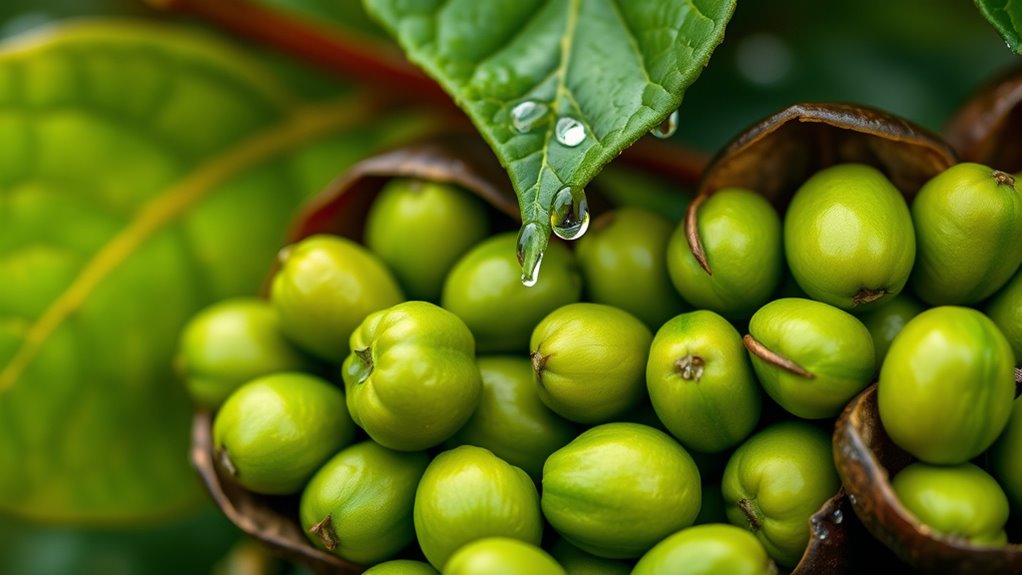
Ever wondered what those little green gems look like before they become your morning brew?
Green coffee beans are pale green and packed with potential! They’ve got an ideal moisture content of 10-12%, keeping them fresh and mold-free.
You might be surprised to learn that their density varies, sitting around 1,300-1,400 kg/m³, depending on that moisture. Plus, they’re hygroscopic, which means they love to absorb moisture from the air—kind of like how we all soak up good vibes!
When you pick them, you’ll notice their uniform size and shape, essential for that perfect roast. The rich flavors of ground coffee emerge after the roasting process, highlighting the true essence of these beans.
Your coffee journey starts here!
Cultivation Traits Impacting Green Coffee
When you’re diving into the world of green coffee, you’ll quickly realize that the environment where those beans grow plays a huge role in how they turn out.
Think about it—optimal temperatures, rainfall, and soil quality are key cultivation practices that shape flavor. For instance, Arabica beans love cooler, high-altitude areas, while Robusta thrives at lower spots.
And don’t forget about those rich volcanic soils! They can make a world of difference. Additionally, beans grown at high elevations often enhance flavor profiles due to their slower growth.
Market Availability and Sourcing Options
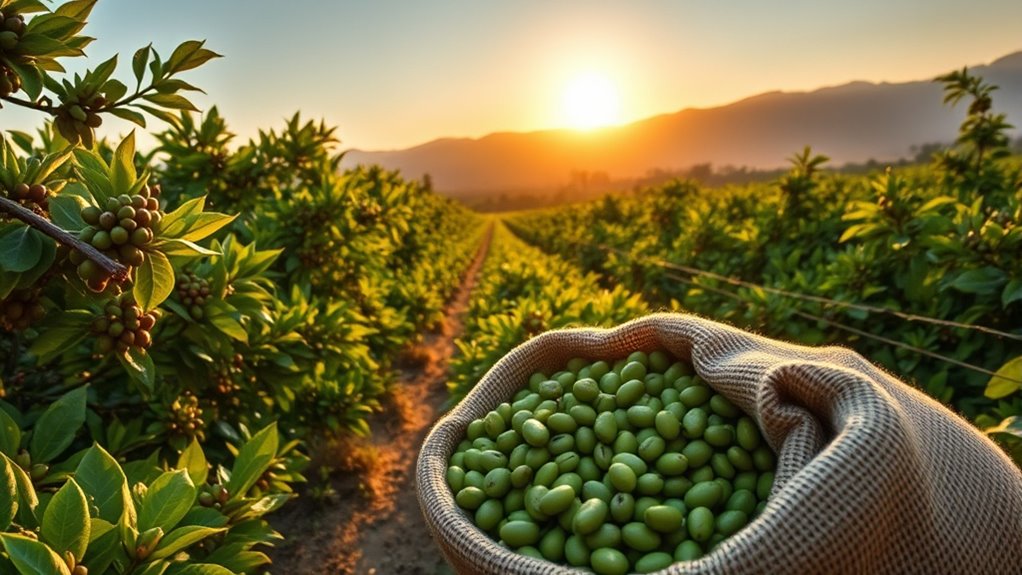
If you’ve ever tried to find the perfect green coffee, you know it can be a bit of a treasure hunt. With market trends changing and sourcing strategies evolving, staying informed is key. Here’s a quick look at your options:
| Region | Key Benefits | Popular Varieties |
|---|---|---|
| Latin America | High-quality beans | Colombian, Brazilian |
| Africa | Unique flavors | Ethiopian, Kenyan |
| Asia-Pacific | Sustainable practices | Vietnamese, Indonesian |
Embrace the adventure! Explore various sources, keep an eye on prices, and remember—finding that perfect brew is worth the effort! Kenyan coffee, known for its rich flavors, is a standout choice for those seeking a unique coffee experience.
Influence of Green Coffee on Flavor Profiles
Have you ever wondered how green coffee can completely change a drink’s flavor profile? It’s like discovering a secret ingredient!
With its grassy, herbal notes and mild, crisp acidity, green coffee offers flavor complexity that roasted beans can’t match. Depending on your brewing techniques, you can highlight those delicate flavors.
Steeping it like tea brings out those subtle vegetal and slightly bitter notes, but don’t forget to play with milk or sweeteners to balance things out. Additionally, the storage conditions of green coffee can significantly impact its flavor and freshness.
It’s a fun way to sip something different, and trust me, your taste buds will thank you for the adventure!
Importance of Green Coffee in the Roasting Process
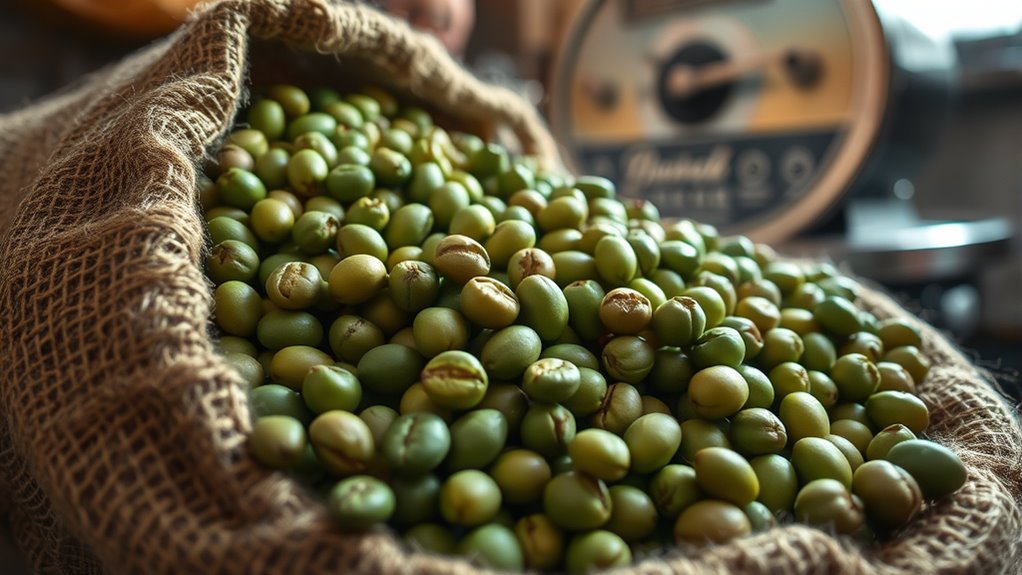
Green coffee is like the unsung hero of your favorite brew, playing an essential role in the roasting process that you mightn’t even think about!
It’s all about moisture management, folks! Before roasting, those beans chill with 8-12% moisture, which needs to evaporate for that perfect roast. Keeping an eye on this moisture is key to roasting consistency.
Too much or too little can mess with flavor and weight, which nobody wants! Plus, quality beans make all the difference—they’re the secret to revealing those amazing aromas and flavors. Additionally, the right water quality can significantly enhance the extraction process during brewing, ensuring that each cup is as flavorful as possible.
